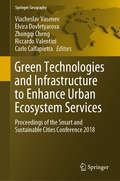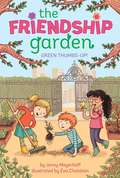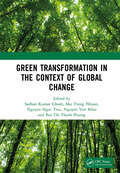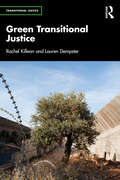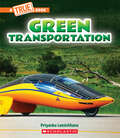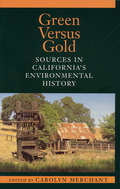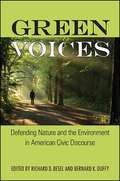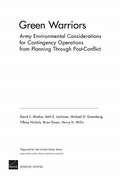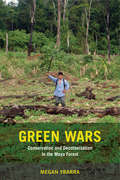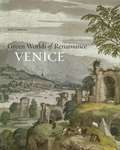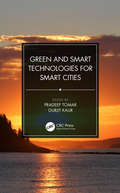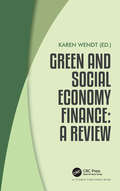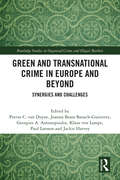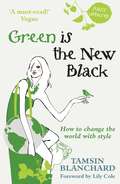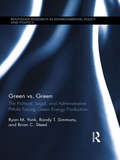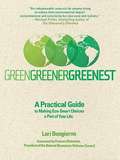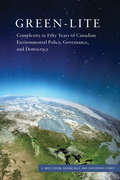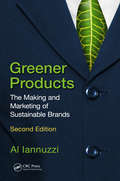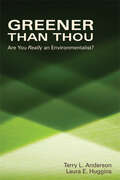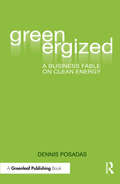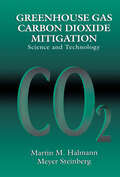- Table View
- List View
Green Technologies and Infrastructure to Enhance Urban Ecosystem Services: Proceedings of the Smart and Sustainable Cities Conference 2018 (Springer Geography)
by Riccardo Valentini Carlo Calfapietra Elvira Dovletyarova Viacheslav Vasenev Zhongqi ChengThese proceedings of the Smart and Sustainable Cities Conference (SSC) in Moscow from May 23 to 26, 2018 addresses important questions regarding the global trend of urbanization. What are the environmental consequences of megacities’ expansion? What smart solutions can make life in cities safe, comfortable and environmentally friendly? It is projected that 70% of the global population will live in cities by 2050, and as such the book describes how this rapid urbanization will alter the face of the world. Focusing on solutions for the environmental problems of modern megapolises, it discusses advanced approaches and smart technologies to monitor, model and assess the environmental consequences and risks. The contributors present examples of successful sustainable urban development, including management and design of green infrastructure, waste management, run-off purification and remediation of urban soils. The SSC conference and its proceedings offer a valuable contribution to sustainable urban development, and are of interest to the scientific and research community, municipal services, environmental protection agencies, landscape architects, civil engineers, policy makers and other stakeholders in urban management and greenery.
Green This! Volume 1
by Deirdre ImusChange the way you clean and keep your family's home wholesome and healthy with the help of expert and activist Deirdre Imus. We all grew up thinking chemical smells like bleach and ammonia signaled "clean." But as Deirdre Imus reveals, some of the chemicals we use to maintain our homes are doing us and our families much more harm than good. In Greening Your Cleaning, the first in her Green This! series, Deirdre shows how cleaning house the environmentally responsible way can be as effective and often cheaper than the more traditional, toxic, means. This volume includes: Simple, efficient cleaning methods for every room of the house Spotlights on everyday products (all purpose cleaner, glass/window cleaner, laundry detergent) and the toxic ingredients you should be wary of Summaries of the latest research on the toxic effects of ordinary chemicals Resource lists of widely available "green cleaning" products and retailers Filled with tips and testimonials, Greening Your Cleaning will show you how to streamline your cleaning products and practices, and how easy it is to make "living green" your way of life.
Green Thumbs-Up!
by Éva Chatelain Jenny MeyerhoffTo make a new city feel like home, Anna gets involved with a community garden--and cultivates new friendships as well as flowers and vegetables--in the first book in the Friendship Garden series.It may be the orange and red season of fall, but eight-year-old Anna Fincher feels nothing but gray. She and her family have just moved to Chicago for her mom's new job. Not only does Anna miss her tiny hometown and her true-blue best friends, but she misses her garden. Over the summer she and her friends had been growing big red tomatoes, bright green beans, and pink raspberries on a small plot of land in Anna's backyard. Now, just when it's fall harvest time back home, Anna is stuck in a boring apartment with no yard, and starting a brand-new school with kids who are anything but friendly. Until one day Anna makes an amazing discovery: a little community garden right in the middle of the city. And a small idea begins to take root in a big way. What if a bunch of kids took over a neglected, forgotten little garden plot? Could they make anything bloom--even friendship?
Green Transformation in the Context of Global Change: Proceedings of the International Conference on Green Transformation in the Context of Global Change (GREEN 2024), Hanoi, Vietnam, October 24th–25th, 2024
by Sadhan Kumar Ghosh Mai Trong Nhuan Nguyen Ngoc Truc Nguyen Viet Khoi Huong, Bui Thi ThanhThis book captures the proceedings of the International Conference on Green Transformation in the Context of Global Change (GREEN 2024), organized by the School of Interdisciplinary Sciences and Arts, Vietnam National University, Hanoi. Each of the eight sections in this volume offer an interdisciplinary forum to exchange valuable information and knowledge on green transformation.It emphasizes the need for new, flexible and creative solutions to tackle the enormous challenges of global change such as geopolitical conflicts, climate change, environmental degradation, biodiversity loss, clean water and food shortage, economic instability, poverty, and social inequality.It touches upon several crucial topics, including: Green transformation in the digital transformation context Emission reduction and energy transition Agro-ecology and sustainable food systems It will be a valuable read for researchers and practitioners of waste management, green manufacturing, sustainable development and climate change.
Green Transitional Justice (Transitional Justice)
by Rachel Killean Lauren DempsterThis book rethinks the boundaries of transitional justice, urging scholars and practitioners to confront the often-overlooked nexus between mass violence and ecological harm.Through an in-depth analysis of the field’s limitations – such as its anthropocentric legalism, neocolonial practices, and alignment with neoliberalism – the book critiques the historical marginalisation of Nature in transitional justice discourse and practice. It argues that ignoring environmental harm not only undermines the possibility of holistic justice but also perpetuates structural violence and inequality. In response, the book sketches a ‘greener’ transitional justice, integrating principles from environmental justice, Indigenous knowledge systems, and ecocentric perspectives. It explores the possibilities of recognising Nature as a victim of mass violence, adapting existing mechanisms to incorporate environmental harm, and fostering transformative approaches premised on the interdependence of human and ecological well-being.This book is written for students, researchers, and practitioners of transitional justice and fields related to conflict transformation, peacebuilding, environmental protection, and development.
Green Transportation (A True Book (Relaunch))
by Priyanka LamichhaneEnvision a brighter future with this STEM-based subset of True Books.Electric cars. Solar-powered planes. Poop-fueled trucks. Each of these technological advances in transportation is bringing us ever closer to a green future, and more are being developed all the time. Considering how many vehicles are on our roads = and in the water and air = sustainable transportation might be the most important innovation we can make to ensure our planet's future. Learn how in Green Transportation.ABOUT THE SERIES:What would a green future look like? Will trains and airplanes be powered by the sun? Will we have homes that have zero impact on the environment? The most pressing challenge facing us today is how to ensure a healthy Earth for ourselves and future generations. This STEM-based set of A True Books introduces students to the engineering innovations that can help us reach those goals. Interesting information is presented in a fun, friendly way = and in the simplest terms possible = and will inspire kids to start envisioning and enacting a more sustainable future.
Green Versus Gold: Sources In California's Environmental History
by Carolyn MerchantWhile the state of California remains one of the most striking and varied landscapes in the world, it has experienced monumental changes since European settlers first set foot there. The past two centuries have witnessed an ongoing struggle between environment and economy, nature and humanity that has left an indelible mark on the region.Green Versus Gold provides a compelling look at California's environmental history from its Native American past to conflicts and movements of recent decades. Acclaimed environmental historian Carolyn Merchant has brought together a vast storehouse of primary sources and interpretive essays to create a comprehensive picture of the history of ecological and human interactions in one of the nation's most diverse and resource-rich states.For each chapter, Merchant has selected original documents that give readers an eyewitness account of specific environments and periods, along with essays from leading historians, geographers, scientists, and other experts that provide context and analysis for the documents. In addition, she presents a list of further readings of both primary and secondary sources. Among other topics, chapters examine:California's natural environment and Native American lands the Spanish and Russian frontiers environmental impacts of the gold rush the transformation of forests and rangelands agriculture and irrigation cities and urban issues the rise of environmental science and contemporary environmental movement.Merchant's informed and well-chosen selections present a unique view of decades of environmental change and controversy. Historians, educators, environmentalists, writers, students, scientists, policy makers, and others will find the book an enlightening and important contribution to the debate over our nation's environmental history.
Green Voices: Defending Nature and the Environment in American Civic Discourse (SUNY Press Open Access)
by Richard D. Besel; Bernard K. DuffyThe written works of nature's leading advocates—from Charles Sumner and John Muir to Rachel Carson and President Jimmy Carter, to name a few—have been the subject of many texts, but their speeches remain relatively unknown or unexamined. Green Voices aims to redress this situation. After all, when it comes to the leaders, heroes, and activists of the environmental movement, their speeches formed part of the fertile earth from which uniquely American environmental expectations, assumptions, and norms germinated and grew. Despite having in common a definitively rhetorical focus, the contributions in this book reflect a variety of methods and approaches. Some concentrate on a single speaker and a single speech. Others look at several speeches. Some are historical in orientation, while others are more theoretical. In other words, this collection examines the broad sweep of US environmental history from the perspective of our most famous and influential environmental figures.This book is freely available in an open access edition thanks to Knowledge Unlatched—an initiative that provides libraries and institutions with a centralized platform to support OA collections and from leading publishing houses and OA initiatives. Learn more at the Knowledge Unlatched website at: https://www.knowledgeunlatched.org/, and access the book online at the SUNY Open Access Repository at http://hdl.handle.net/20.500.12648/7126.
Green Warriors
by Michael D. Greenberg David E. Mosher Brian Rosen Tiffany Nichols Beth E. LachmanThis study assesses whether Army policy, doctrine, and guidance adequately address environmental activities in post-conflict phases of contingencies. A review of policy, doctrine, operational experience, and documentation, as well as interviews with Army personnel, indicates that environmental concerns can have significant impacts. Recommendations are made for improving the Army?s approach to environmental issues in contingency operations.
Green Wars: Conservation and Decolonization in the Maya Forest
by Megan YbarraGlobal conservation efforts are celebrated for saving Guatemala’s Maya Forest. This book reveals that the process of protecting lands has been one of racialized dispossession for the Indigenous peoples who live there. Through careful ethnography and archival research, Megan Ybarra shows how conservation efforts have turned Q’eqchi’ Mayas into immigrants on their own land, and how this is part of a larger national effort to make Indigenous peoples into neoliberal citizens. Even as Q’eqchi’s participate in conservation, Green Wars amplifies their call for material decolonization by recognizing the relationship between Indigenous peoples and the land itself.
Green Worlds of Renaissance Venice
by Jodi CranstonFrom celebrated gardens in private villas to the paintings and sculptures that adorned palace interiors, Venetians in the sixteenth century conceived of their marine city as dotted with actual and imaginary green spaces. This volume examines how and why this pastoral vision of Venice developed.Drawing on a variety of primary sources ranging from visual art to literary texts, performances, and urban plans, Jodi Cranston shows how Venetians lived the pastoral in urban Venice. She describes how they created green spaces and enacted pastoral situations through poetic conversations and theatrical performances in lagoon gardens; discusses the island utopias found, invented, and mapped in distant seas; and explores the visual art that facilitated the experience of inhabiting verdant landscapes. Though the greening of Venice was relatively short lived, Cranston shows how the phenomenon had a lasting impact on how other cities, including Paris and London, developed their self-images and how later writers and artists understood and adapted the pastoral mode.Incorporating approaches from eco-criticism and anthropology, Green Worlds of Renaissance Venice greatly informs our understanding of the origins and development of the pastoral in art history and literature as well as the culture of sixteenth-century Venice. It will appeal to scholars and enthusiasts of sixteenth-century history and culture, the history of urban landscapes, and Italian art.
Green Worlds of Renaissance Venice
by Jodi CranstonFrom celebrated gardens in private villas to the paintings and sculptures that adorned palace interiors, Venetians in the sixteenth century conceived of their marine city as dotted with actual and imaginary green spaces. This volume examines how and why this pastoral vision of Venice developed.Drawing on a variety of primary sources ranging from visual art to literary texts, performances, and urban plans, Jodi Cranston shows how Venetians lived the pastoral in urban Venice. She describes how they created green spaces and enacted pastoral situations through poetic conversations and theatrical performances in lagoon gardens; discusses the island utopias found, invented, and mapped in distant seas; and explores the visual art that facilitated the experience of inhabiting verdant landscapes. Though the greening of Venice was relatively short lived, Cranston shows how the phenomenon had a lasting impact on how other cities, including Paris and London, developed their self-images and how later writers and artists understood and adapted the pastoral mode.Incorporating approaches from eco-criticism and anthropology, Green Worlds of Renaissance Venice greatly informs our understanding of the origins and development of the pastoral in art history and literature as well as the culture of sixteenth-century Venice. It will appeal to scholars and enthusiasts of sixteenth-century history and culture, the history of urban landscapes, and Italian art.
Green and Smart Technologies for Smart Cities
by Pradeep Tomar Gurjit KaurThe book starts with an overview of the role of cities in climate change and environmental pollution worldwide, followed by the concept description of smart cities and their expected features, focusing on green technology innovation. This book explores the energy management strategies required to minimize the need for huge investments in high-capacity transmission lines from distant power plants. A new range of renewable energy technologies modified for installation in cities like small wind turbines, micro-CHP and heat pumps are described. The overall objective of this book is to explore all the green and smart technologies for designing green smart cities.
Green and Social Economy Finance: A Review
by Karen WendtGreen and Social Economy Finance is a compilation of chapters by experts, linking research and practice. This anthology provides a new thinking on social economy green finance, showing emerging themes and trends. It spans from stock markets, green finance, innovations, digitalization to social finance, governance and theories of change. It concentrates on impact, opportunity recognition and development of financial products designed to finance the green and social economy. Without the attraction of capital, social entrepreneurship, and innovations, green finance can face difficulty in addressing business solutions. Green and social economy is a nascent field. The authors address the conceptualization of green and social solutions and identify new trends in the finance industry products and approaches. The book demonstrates that aligning finance and investment with the Paris Agreement, sustainable development goals and needs and interests of society are feasible.
Green and Transnational Crime in Europe and Beyond: Synergies and Challenges (Routledge Studies in Organised Crime)
by Georgios A. Antonopoulos Klaus Von Lampe van Duyne, Petrus C. Joanna Banach-Gutierrez Paul Larsson Jackie HarveyThis book brings together research and studies in the fields of organised crime and of ‘green criminality’ against the natural environment. By bringing the research traditions of organised crime and ‘green criminology’ into closer proximity and combining contributions on traditional organised crime and ecological crime in one volume, it questions the need to draw artificial dividing lines between criminological sub-disciplines. Including chapters on the illegal trade in cobalt, in stolen motor vehicles, the illegal dog market, cross- border amber trafficking, deforestation and environmental harm in the Norwegian industrial salmon farming, the book offers an important rapprochement between studies in organised crime and green criminology, and considers the operational differences between underworld and upperworld criminal economies.
Green is the New Black: How to Save the World in Style
by Tamsin BlanchardFor girls who care about global warming, and next season's hot looks, Green is the New Black is a must-have accessory. Does our shopping addiction contribute to climate change? What's so special about organic cotton? Who are the real fashion victims behind the £3 jeans? From the truth about fast fashion to the best biodegradable shoes, from guilt-free spending sprees to the joys of swishing parties, Tamsin Blanchard is your guide to all things fairtrade and fabulous. She explains the principles of ethical fashion, from why it matters to how to do it. Offers tips for the aspiring green goddess: including how to knit your own scarf, seduction in eco-couture, the best places to shop for vintage sunglasses, and ethical bling. And includes fun facts and essential directories on every aspect of sustainable stylish living. With fashion secrets from celebrity friends, Green is the New Black is the chicest, greenest survival manual around. If you want to change the world, and your wardrobe, don't go shopping without it.
Green vs. Green: The Political, Legal, and Administrative Pitfalls Facing Green Energy Production (Routledge Research in Environmental Policy and Politics)
by Ryan M. Yonk Randy T. Simmons Brian C. SteedRenewable and carbon-neutral energy have been promoted as the future of energy production in the United States. Non-traditional energy sources show promise as alternatives to fossil fuels and may provide a sustainable source of energy in increasingly uncertain energy markets. However, these new sources of energy face their own set of political, administrative, and legal challenges. Green vs. Green explores how mixed land ownership and existing law and regulation present serious challenges to the development of alternative energy sources in the United States. Analytically examining and comparing five green energy sectors; wind, solar, geothermal, biofuel and hydro power, Ryan M. Yonk, Randy T. Simmons, and Brian C. Steed argue that discussing alternative energy without understanding these pitfalls creates unrealistic expectations regarding the ability to substitute "green" energy for traditional sources. The micro-goals of protecting individual areas, species, small-scale ecosystems, and other local environmental aims often limits ability to achieve macro-goals like preventing global climate change or transitioning to large-scale green energy production. Statutes and regulations designed to protect environmental and cultural integrity from degradation directly conflict with other stated environmental ends. Although there is substantial interest in adding clean energy to the grid, it appears that localized environmental interests interfere with broader environmental policy goals and the application of existing environmental laws and regulations may push us closer to gridlock. Green vs. Green provides a fascinating look into how existing environmental law created or will create substantial regulatory hurdles for future energy generations.
Green, Greener, Greenest
by Lori Bongiorno Frances BeineckeHow green can you be? Green: Drive the speed limit Greener: Drive a fuel-efficient car Greenest: Bike or walk The perfect guide to help readers decide how to best spend their time and money to protect the environment, Green, Greener, Greenest offers flexible tips for everyday living, all categorized as "green," "greener," and "greenest." Cutting through the labeling and the hype, it helps readers choose the advice that fits their schedule, their budget, and their interests, with the understanding that there's never one "right way" to make a difference. This indispensable resource will grow with readers-whether a novice in green living or a veteran environmentalist-as their interests and needs change over time.
Green-lite
by Christopher Stoney G. Bruce Doern Graeme AuldAnchored in the core literature on natural resources, energy production, and environmental analysis, Green-lite is a critical examination of Canadian environmental policy, governance, and politics drawing out key policy and governance patterns to show that the Canadian story is one of complexity and often weak performance. Making a compelling argument for deeper historical analysis of environmental policy and situating environmental concerns within political and fiscal agendas, the authors provide extended discussions on three relatively new features of environmental policy: the federal-cities and urban sustainability regime, the federal-municipal infrastructure regime, and the regime of agreements with NGOs and businesses that often relegate governments to observing participants rather than being policy leaders. They probe the Harper era's muzzling of environmental science and scientists, Canada's oil sands energy and resource economy, and the government's core Alberta and Western Canadian political base. The first book to provide an integrated, historical, and conceptual examination of Canadian environmental policy over many decades, Green-lite captures complex notions of what environmental policy and green agendas seek to achieve in a business-dominated economy of diverse energy producing technologies, and their pollution harms and risks.
Green-lite: Complexity in Fifty Years of Canadian Environmental Policy, Governance, and Democracy (Carleton Library Series)
by Christopher Stoney G. Bruce Doern Graeme AuldAnchored in the core literature on natural resources, energy production, and environmental analysis, Green-lite is a critical examination of Canadian environmental policy, governance, and politics drawing out key policy and governance patterns to show that the Canadian story is one of complexity and often weak performance. Making a compelling argument for deeper historical analysis of environmental policy and situating environmental concerns within political and fiscal agendas, the authors provide extended discussions on three relatively new features of environmental policy: the federal-cities and urban sustainability regime, the federal-municipal infrastructure regime, and the regime of agreements with NGOs and businesses that often relegate governments to observing participants rather than being policy leaders. They probe the Harper era’s muzzling of environmental science and scientists, Canada’s oil sands energy and resource economy, and the government’s core Alberta and Western Canadian political base. The first book to provide an integrated, historical, and conceptual examination of Canadian environmental policy over many decades, Green-lite captures complex notions of what environmental policy and green agendas seek to achieve in a business-dominated economy of diverse energy producing technologies, and their pollution harms and risks.
Greener Products: The Making and Marketing of Sustainable Brands, Second Edition
by Al IannuzziWritten by a renowned sustainability expert, Greener Products: The Making and Marketing of Sustainable Brands, Second Edition makes the case for why the people and the planet need products to be made in a different, more sustainable way. The growth of the global middle class, with an additional 3 billion people expected to enter the consumer market by 2030, is putting an unprecedented demand on resources and straining the global supply of raw materials, fossil fuels, food and water. This book provides insights on how to raise the bar on product development and investigates the best practices for making and marketing sustainable brands. Over 40 case studies are analyzed in this book and summarized for the reader to easily see what it is that makes leading companies successful. Analysis on marketing campaigns and greener product development range from leading companies like Apple, Nike, Samsung Electronics, BASF, GE, Johnson & Johnson, Unilever, and Method. New updated content in this second edition includes: New developments like the United Nations Sustainable Development Goals with concepts of biomimicry, circular economy, emerging issues management, and eco-innovation. Novel tools and examples for bringing sustainable products to market. New chapter dedicated to natural capital. Analysis of current green marketing methods and market trends. Best practices for making and marketing sustainable brands. For more information, visit the author's book website at www.greenerproducts.biz.
Greener than Thou: Are You Really An Environmentalist?
by Terry L. Anderson Laura E. HugginsIn a powerful argument for free market environmentalism, Terry Anderson and Laura Huggins break down liberal and conservative stereotypes of what it means to be an environmentalist. They show that, by forming local coalitions around market principles, stereotypes are replaced by pragmatic solutions that improve environmental quality without necessarily increasing red tape.
Greenergized: A Business Fable on Clean Energy
by Dennis PosadasRenewable energy versus fossil fuels: the debate rages on, worldwide. At stake is nothing less than the protection of our planet from the ravages of climate change. But the costs involved in making the switch to clean energy are daunting. How do we pay for solar and wind energy? Do we scrap all our gasoline-driven autos? How do we move forward?Although the importance of this topic is hard to overstate, it nevertheless consistently fails to engage at the level that it so patently needs to. This is what has led technology expert and seasoned commentator Dennis Posadas to approach the issues in a new and intriguing way. Posadas understands that we respond best to narratives, and that is why he has written what he describes as a "green thinking fable". In this fable, we meet Daniel, a young graduate of the fictional Oriental College, who is thrust into a debate between José, an oil man, and Professor Ruiz, an advocate of clean energy. We follow the lines of argument as Daniel's awareness increases, and he experiences a paradigm shift in his thinking. We see how his short-term outlook focusing on the cost of renewable energy evolves into long-term thinking about the cost of not making the shift to renewables. Posadas's business fable puts the issues in front of the general reader in an engaging and digestible way. It covers concepts such as solar, wind, electric vehicles, waste to energy, feed-in-tariffs, carbon tax, intermittent sources, cost of fossil fuels, health impact of fossil fuel use, energy efficiency, and other relevant topics necessary for understanding this debate. The story and characters may be fictional, but the situations and the technology discussions are based on current facts. Decide for yourself where you stand on the renewables versus fossil fuels debate, and discuss this story with your friends and colleagues. Greenergized is a much-needed route into the issues surrounding the most serious debate our generation faces. And it pulls off the brilliant trick of being highly readable at the same time.
Greenhouse Gardening
by Sunset Publishing StaffGreenhouse Gardening takes the reader through the intricacies of uding modern greenhouses to grow plants. Building a greenhouse, choosing plants, and special features of greenhouses are covered.
Greenhouse Gas Carbon Dioxide Mitigation: Science and Technology
by Martin M. Halmann Meyer SteinbergAny mention of the "greenhouse effect" tends to ignite controversy. While the rising atmospheric concentrations of greenhouse gases-especially carbon dioxide- are certainly among the most pressing issues today, theoretical and perceived consequences have been subject to conjecture and misinformation. That raging debate has obscured an important
